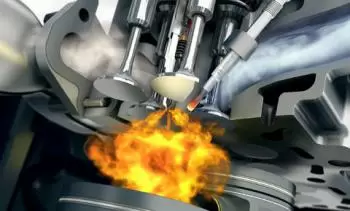
Thermal engines are classified according to these characteristics:
- Where the combustion takes place: external combustion or internal combustion.
- Fuel used and type of ignition: Otto or diesel.
- Type of movement of the mobile elements: alternative or rotating.
- Cycle type: 2-stroke cycles, 4-stroke cycles.
- Number of cylinders: single cylindrical or poly cylindrical.
- Cylinder arrangement: in-line cylinders, V-cylinders, opposite horizontal cylinders.
What are exothermic and endothermic motors?
Depending on the place where combustion takes place, we distinguish two types: exothermic or external combustion and endothermic or internal combustion.
In exothermic engines combustion takes place outside the machine (steam engine). These types of machines are not used in the automotive industry.
In endothermic engines the combustion process takes place indoors. They are those used in self-propelled vehicles (cars, trucks, boats ...).
Types of engines depending on the fuel used and the type of ignition
Depending on the fuel used and the type of ignition, we distinguish the following types of thermal engines:
- Otto engines. They use gasoline as fuel. The ignition is by spark.
- Diesel engines. They use diesel as fuel. The ignition is by compression.
Explosion engines (Otto) can also be called spark ignition. For the operation of this type of engines they generally use a mixture of air and gasoline, which ignites due to the electrical spark caused by the ignition system. Otto engines withstand moderate pressures that make it reach a high number of revolutions: they reach maximum power at speeds between 5,500 and 7,000 revolutions per minute.
Diesel is also called compression ignition. To operate they use heavy fuels, preferably diesel. Combustion begins with the ignition of the diesel fuel, injected finely pulverized and at high pressure, into the strongly compressed air and at a high temperature. Diesel engine components must be robust and heavy to withstand the high pressures at which they operate. This causes the maximum operating revolutions per minute to be limited.
There are two types depending on the revolutions per minute they can reach:
- Fast diesels: Fast diesels have speeds of around 5,000 revolutions per minute. They are mounted on passenger cars and light commercial vehicles.
- Slow diesels: Slow diesels rotate between 900 and 2,000 revolutions per minute approximately, with a unit displacement that can reach 2,000 cc. They are mounted on trucks, buses, locomotives, ships, and heavy machinery.
What are reciprocating and rotary engines?
Volumetric motors are those in which mobile elements generate, through movement, variable volumes between a maximum value and a minimum value. According to this definition we can divide the motors into two types:
- Alternatives: A piston moves through a cylinder with an alternative linear movement that becomes rotary through a connecting rod-crank mechanism. This type of engine is practically always used in the automotive sector.
- Rotary: Also called Wankel motor. The rotary movement is generated directly in a piston with a triangular section, which rotates inside a housing where it forms 3 chambers. It works by following the four-cycle Otto cycle. It does not have valves, therefore the admission and the exhaust are made through vents. Its use in the automotive industry is very limited.
What are the possible cycles of heat engines?
This is an important classification of heat engines. According to the way of performing the cycle we can distinguish:
- 4-stroke cycles
- 2-stroke cycles
Four-stroke engines perform the four-stroke duty cycle - Intake, Compression, Explosion-Expansion, and Exhaust - in four piston strokes, over two full crankshaft turns. Gas exchange is controlled by valves that open and close the intake and exhaust ducts. They can be diesel or explosion.
In two-stroke engines, the four-stroke duty cycle is carried out in two strokes of the piston and, therefore, one turn of the crankshaft. This justifies that this type provides more power than the four-stroke with the same displacement. Gas exchange is done through vents controlled by the piston when traveling, which negatively affects performance and makes contamination control difficult. They can be Otto, which equips small displacement motorcycles, or diesel, which are large displacement and are used for the propulsion of aquatic vehicles and in industrial machinery.
Type of heat engines according to cylinders
Depending on the number of cylinders that a thermal engine has, we can distinguish single-cylinder and poly-cylinder.
- Single cylinder: These are thermal engines that only have a single cylinder.
- Polycylindrical: These types of engines have more than one cylinder. Almost all motor vehicles, with the exception of motorcycles, are poly-cylinder.
In relation to cylinders, engines can also be classified according to the arrangement of these cylinders. In this way, the following types can be distinguished:
- Cylinders in line
- V-cylinders
- Opposite horizontal cylinders
Cylinder engines in line : On a single block the cylinders are arranged one after the other: This arrangement is used in engines from 2 to 6 cylinders and up to 8 in diesel.
V-cylinder engines : They consist of a double V-block that forms an angle between them of 60 or 90º. In this type, two pistons work on the same elbow of the crankshaft, one from each block.
A variant of this type is the double V (W). This designation applies to engines with more than two rows of cylinders, which have a single common crankshaft. In this way, W8, W10, W12 and W16 motors are obtained, with a very compact size, a very balanced operation and a very low level of vibrations.
Opposite horizontal cylinder engines : The cylinders are arranged in two blocks joined horizontally by the base with a common crankshaft. The height of this engine is greatly reduced. They can be 2, 4 or 6 cylinders.



